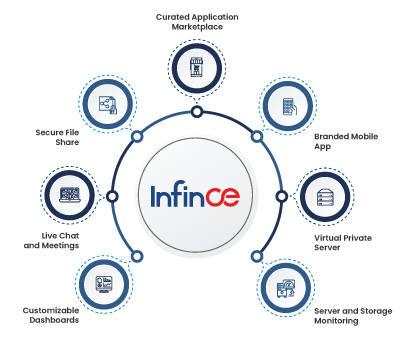The cloud offers a host of benefits in terms of cost-savings, speed, efficiency, improvements, and more. However, unless the migration is done right, much of the benefits of the cloud do not realize, and worse, the disruption may make the enterprise dysfunctional without anything to gain in return.
5 Expert Tips for Effective Cloud Migration
To help you empower the best of cloud, here’s a checklist for efficient cloud migration.
1. Determine the Reasons for Migration
Migration to the cloud because everyone else is doing is an exercise doomed to failure. Identify a pressing need for migrating to the cloud, or specifically be clear of the gains to be achieved through migration. The benefits could be process efficiency, cost savings, ability to serve customers better, ability to operate from a wider geographical footprint, or anything else.
Perform an objective SWOT analysis of the possible benefits, disadvantages, opportunities, and threats, of the specific asset migration, before committing to the exercise. Migrating to the cloud entails a lot of investment in time and resources, would also cause a disruption to the entrenched ecosystem of the company, and force a learning curve on the employees. Unless the benefits, at least in the long run, outweigh the investment, the enterprise is better off with the status quo.
2. Assess the Environment
Having committed to the migration, decide on the specific applications to be migrated. Not all processes benefit from migrating to the cloud, and many legacy apps or software is best left on the on-premises servers. For instance, it may not be a wise decision to migrate or replace a performance-intensive legacy app that works fine.
Having identified the apps to be migrated to the cloud, analyze the infrastructure used by such apps, in terms of the storage consumed, the data generated, the resources required for Big Data analytics, and so on. Provision for any required enhancements. Next, identify a suitable cloud environment with compatible resources, and determine the architecture needed for the migration.
Migration may be shallow cloud or deep cloud. Shallow cloud integration, also known as “lift-and-shift” entails moving the on-premise application to the cloud, with little or no changes except whatever is required to run the applications in the new environment. Deep cloud integration entails modification of the application during the migration process to leverage key cloud capabilities such as auto-scaling and dynamic load balancing.
Another consideration is opting for a simple, single provider or for a multi-cloud approach. The latter approach, more commonplace, involves splitting applications over multiple cloud providers or developing in a cloud-agnostic approach.
Many enterprises underestimate the migration costs. Costs vary considerably, depending on the nature of the applications being migrated. For instance, costs for applications that constantly run vary greatly from costs for applications that spin up and spin down upon completion of the job. For example, in AWS On-Demand instances, subscribers pay for computing capacity by per hour or per second, depending on the instances run.
There is also the option or private cloud and public clouds. Public clouds keep costs low, but may offer only limited levels of latency and security.
3. Select the right cloud provider
Identifying a migration architect responsible for planning and completing all aspects of the migration, and taking all decisions and a technical plan is essential and should be one of the earliest decisions after committing to migration.
In most cases, it becomes essential to rope in an external partner who has specialized experience in cloud migration. Make sure the selected partner is capable of meeting the architectural requirement, has redundant servers to ensure near 100% uptime, and offers flexible plans to scale-up and scale-down resources on demand. Pay special attention to the SLA and the support capabilities of the selected provider.
4. Execute the Migration
The cloud migration process culminates with the actual migration of resources from the legacy on-premises legacy server to the new cloud server.
Chalk out a migration plan, which details the timeline and methodology of the actual file transfer. The key steps in the migration plan are:
- Lay down the order of migration of application and data.
- Schedule the time of migration, while causing minimal disruption to company operations. Schedule the migration during the night, or when operations are at a lull.
- Back up the data on existing servers, and make sure the backup is easily retrievable if the need arises.
- Set up the cloud environment. Provision the cloud servers and connections and test all the individual components.
- Finally, transfer the data. Enterprises have the option of making the actual switch all at once or move a few customers at a time. Migrating the first data load will invariably take some time.
Post-transfer, test all the connection again fully and ensure the system is up and running. Make sure all the migrated data is present and available, and the environment is secure.
The migration process may not be entirely smooth and straightforward. Several potential issues, both anticipated and unanticipated, could emerge as roadblocks. Take all possible precautions to counter such eventualities, and be ready to make impromptu changes and tackle any unexpected issue that emerges head-on. An open line of communication with the customer support team of the selected cloud partner helps.
5. Monitor the New Environment
The migration process does not end with the transfer of files. Issues may flare up in the cloud environment as the apps are used, and as such it is important to set up a dedicated monitoring system for a while, to identify and fix any potential issues.
Migration to the cloud may force some changes to end-user processes. Employees may have to be trained on the new method and a slowdown taken cognizance of during the learning curve. Any changes to customer-facing processes may have to be explained through blogs, emails or other documentation.
Another important post-migration consideration is resource optimization. The cloud is optimized for dynamic resource allocation, and as such, plan for distributing resources to applications rather than continue with allocating resources statically.
The above steps are only indicative. Each enterprise is unique, and the best approach to migration depends on the company’s infrastructure, environment, incumbent procedures, and future requirements. To experience a smooth transition with cloud, sign up with INFINCE today!





